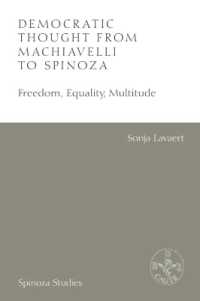Full Description
Pastiche, Fashion and Galanterie in Chardin's Genre Subjects seeks to understand how Chardin's genre subjects were composed and constructed to communicate certain things to the elites of Paris in the 1730s and 1740s. This book argues against the conventional view of Chardin as the transparent imitator of bourgeois life and values so ingrained in art history since the nineteenth century. Instead, it makes the case that these pictures were crafted to demonstrate the artist's wit (esprit) and taste, traits linked to conventions of seventeenth-century galanterie. Early eighteenth-century Moderns like Jean-Simeon Chardin (1699-1779) embraced an aesthetic grounded upon a notion of beauty that could not be put into words-the je ne sais quoi. Despite its vagueness, this model of beauty was drawn from the present, departed from standards of formal beauty, and could only be known through the critical exercise of taste. Though selecting subjects from the present appears to be a simple matter, it was complicated by the fact that the modernizers expressed themselves through the vehicles of older, established forms. In Chardin's case, he usually adapted the forms of seventeenth-century Dutch and Flemish genre painting in his genre subjects. This gambit required an audience familiar enough with the conventions of Lowlands art to grasp the play involved in a knowing imitation, or pastiche. Chardin's first group of enthusiasts accordingly were collectors who bought works of living French artists as well as Dutch and Flemish masters from the previous century, notably aristocratic connoisseurs like the chevalier Antoine de la Roque and Count Carl-Gustaf Tessin.
Contents
ContentsAcknowledgements List of IllustrationsIntroduction Looking Smart Chardin and the Gout Moderne: Reception Chardin and the Gout Moderne: Creation Chardin and the Academy Examples of the Gout Moderne and Examples of Its Critics The Emerging Public Sphere 1. Pastiche Collecting and Pastiche Well Boiled Turnips Make Good Soup Innuendo Self Reference Contrast and Comparison 2. Fashionability Figures de modes Fashionability and Social Ambiguity The Draughtsman La pourvoyeuse Fashionable Governesses The Teetotum 3. Spaces of Imitation Rue du Four The Gout Moderne and Its Practices Diligent Imitators Labor and Leisure Enlightenment Things 4. Negligent Beauty Reading #1: Pastiche, Fashion, and Galanterie Reading #2: Fashion and Piety Reading #3: Chardin and Class 5. Picture Titles The Salon and Picture Titles A Brief History of the Picture Title Chardin and Picture Titles Conclusion BibliographyAbout the Author Index








